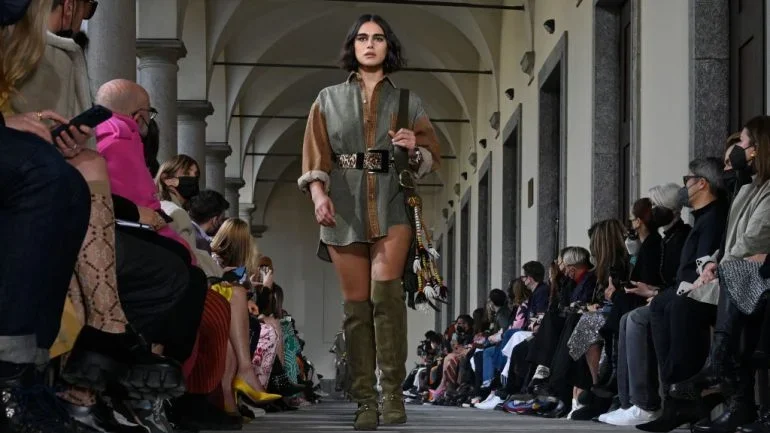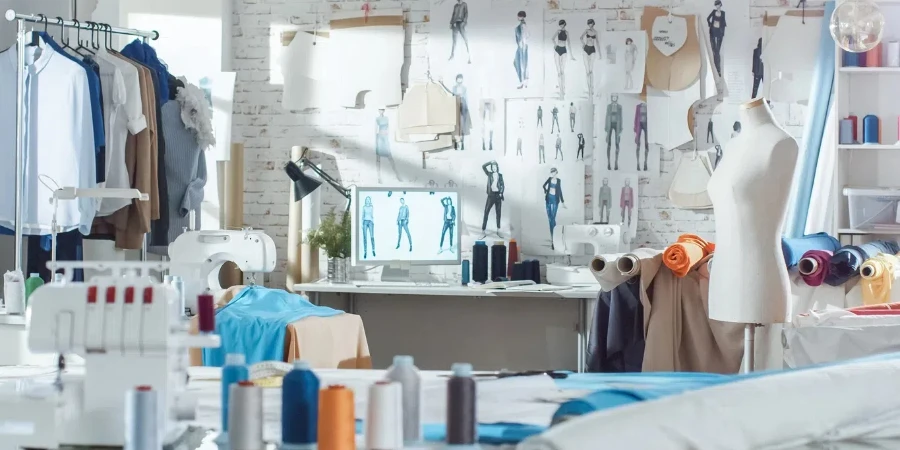Fashion consumers are pushing for cleaner fashion supply chains but there is also growing demands from workers to see more transparency and have a bigger voice in decision-making that could change the manufacturing process in future.

Despite the fashion industry being regarded as the second largest economy in the world, Geraldine Wharry, a fashion futurist at the Trend Atelier, observes that fashion the fashion manufacturing process operates “in the dark” and away from mainstream media.
She points out that 90% of fashion’s emissions currently come from the sourcing and manufacturing stage so she insists that how we make fashion goods needs to be at the centre of fashion’s cultural conversation.
Sustainability in the fashion industry: long-term thinking, systemic change
Over a decade ago, people asked Wharry if sustainability was just a “passing trend” and her response was: “No, it’s just our reality!”
While much remains to be done in the sustainability space, Wharry emphasises the progress being made by the fashion industry, noting that sustainable fashion is increasingly becoming a norm: “Things take time, things are slow. It is a marathon, not a sprint.”
When Wharry was a fashion designer her primary concern was predicting fashion trends. However, her focus has shifted to caring more about the future – what will happen to the industry in the next 10 years and how can it serve the greater good?
Despite being an important industry, she notes that fashion lacks significant influence and still does not have “enough of a seat” at the table regarding policy and governance discussions.
She explains: “We need a vision for a different future, and this needs to be met with a strategic grasp of systemic issues.”
She’s currently working with organisations that are putting a big emphasis on understanding what’s happening in the long-term so society can be prepared for the next biggest shifts.
Wharry advocates for a future-oriented mindset that transcends short-term trends to prioritise ethical systems and ecosystems.
Climate crisis, transparency and ethics
While customers are concerned about climate change and global warming, Wharry warns of a stark contrast between what consumers want, what they say they want, and how they actually purchase.
There is growing concern about where clothing is made, and a significant percentage of companies feel the pressure to reduce their carbon footprint, including a demand from workers for more transparency and a voice in decision-making.
According to Wharry, customers are pushing for greener supply chains, leading more companies to invest in electrification, resource management, and sustainable practices.
With temperatures rising and 2023 regarded as the warmest year on record, the Future Today Institute predicts an “expanded environmental support” ecosystem. This simply means countries should be expanding their environmental efforts beyond the focus on renewable energy and taking a more holistic approach to sustaining healthy natural ecosystems while transitioning to clean energy.
In the current landscape, Wharry asserts that honesty matters even if a business does not have a fully-fledged and rolled-out transparency or sustainability system: “Be transparent about your future strategy and your commitments because businesses and brands should take meaningful action to give themselves a goal that will inspire trust, which is going to be increasingly important.”
With the abundance of critical data and advancements in artificial intelligence (AI), it is difficult for brands to hide behind marketing narratives that don’t reflect reality. Wharry emphasises that beyond relying on the government and regulations, micro-actions and local initiatives such as internal and external communication with a certain degree of “humility” and “honesty” are crucial for transparency.
She also questions prevailing beliefs noting a lack of commitment towards transparency over profits and calling for greater regulatory oversight and corporate responsibility in the fashion system, stating: “This is a complex system we are in.”
Circular economic model: reducing carbon footprint through tech, partnerships
Wharry highlights a recent trend in the fashion industry where companies are playing around with digital IDs, QR codes and other related technologies to help customers understand a garment’s lifecycle.
She believes the roll-out of regulations like the Digital Product Passport (DPP) could potentially birth a new social media ecosystem where consumers can communicate directly with previous owners, companies and even the government.
Wharry also emphasises how retailers and suppliers can leverage AI to track ethical practices and environmental guidelines in the supply chain. She mentions that retailers are “retooling” current manufacturing systems with new AI tools to improve transparency and accountability.
She sees a significant opportunity for developing more innovations that address the growing consumer demand for information about sustainability.
The integration of necessary data will be very important in the era of automation and interconnected information as a lot of what is happening within the fashion supply chain will need to be verified, notes Wharry.
Bringing the focus back to carbon emissions, she underscores the importance of recycling, especially post-production. She argues that there’s little talk about the steps brands can take, such as right-sizing packaging, and reducing oversized boxes, which she claims release 3.5m tonnes of CO2 annually.
Wharry stresses the need for brands to lead consumer conversations on the environmental impact of their purchases. She asserts that companies should start onboarding decarbonisation plans now that legislation is in the pipeline.
Future of the fashion industry
Wharry says considering garment and textiles end of life at the start and promoting regenerated fabrics, and new material innovations will be essential for fashion’s future as it will lead to a circular industry and a regenerative economic model.
She notes a key part of a circular economy will be eliminating waste and pollution and she predicts that in the next five years we’ll see a pivot from single-use packaging: “It’s really about implementing low carbon solutions, and looking at some tools that will also help measure the carbon output, even if it’s not perfect.”
She also believes it is about identifying where the supply chain can recycle or reuse materials.
To do this she suggests tapping into the potential of the creator and influencer industry, especially the ones advocating for sustainability. She notes creators or influencers are storytellers so they can capture their community audience and have meaningful conversations about the issues surrounding fashion sustainability if they are given the correct information to begin with.
There is an influx of sustainability legislation on its way across Europe that will change the fashion supply chain for good. Plus, Amsterdam is doing a pilot project to become a circular city by 2050.
She concludes: “All of this signal that change is on its way and traceability and accountability will become national security imperatives and extractive business models will have nowhere to go.”
Source from Just Style
Disclaimer: The information set forth above is provided by just-style.com independently of Alibaba.com. Alibaba.com makes no representation and warranties as to the quality and reliability of the seller and products. Alibaba.com expressly disclaims any liability for breaches pertaining to the copyright of content.




